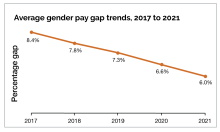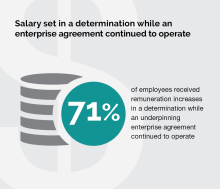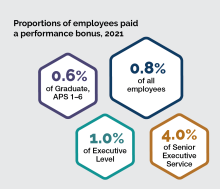Australian Public Service Remuneration Report 2021
Foreword
The Australian Public Service (APS) Remuneration Report 2021 presents a summary of remuneration paid to APS employees under the Public Service Act 1999 as at 31 December 2021. The report provides APS agencies with data that informs their remuneration practices.
This annual report builds on several years of trend information and serves as an important public record for the APS.

Peter Woolcott AO
Australian Public Service Commissioner
August 2022
APS remuneration at a glance 2021

All remuneration components, weighted median change 2020 to 2021
| Classification | Non-SES | SES | All |
|---|---|---|---|
| Base salary | 3.0% | 4.2% | 3.0% |
| Total rem. package | 2.6% | 2.2% | 2.5% |
| Total reward | 2.7% | 2.1% | 2.7% |

Average Base Salary comparison by gender
| Classification | Gender | Average base salary | % between genders |
|---|---|---|---|
| APS 4 | Female | $74,511 | -0.2% |
| Male | $74,382 | ||
| APS 5 | Female | $81,719 | -0.3% |
| Male | $81,478 | ||
| APS 6 | Female | $94,710 | 0.2% |
| Male | $94,915 | ||
| EL 1 | Female | $118,661 | 0.5% |
| Male | $119,312 |
Note: % difference between genders is the difference between male and female average Base Salaries expressed as a % of male earnings. APS 4 - APS 6 and EL 1 classifications make up 77.4% of employees.


Executive summary
Key findings for 2021
- The weighted[1] median Base Salary increase across the APS was 3%. This reflects a weighted median increase of 3% for non-Senior Executive Service (SES) employees and 4.2% for SES employees.
- The weighted median Total Reward increase was 2.7% for non-SES employees and 2.1% for SES employees.
- The difference in overall average remuneration between genders decreased from 6.6% in 2020 to 6% in 2021. A continuing increase in female representation at most senior classifications has influenced this change.
- Over 100,000 employees, or 71% of employees, had their salary set in a determination made under the Public Service Act 1999 while continuing to receive other terms and conditions through an enterprise agreement (or other employment instrument) that had passed its nominal expiry date. Sixty-five agencies provided remuneration increases to employees through a determination rather than bargaining new enterprise agreements.
- 1,100 employees, or 0.8% of employees, were paid a performance bonus. Changes to reporting (which are outlined in the next section) dramatically reduced the number of non-SES performance bonuses reported.
- The number of SES performance bonuses reported remained relatively stable at 115, or 4% of SES employees (compared to 4.2% in 2020).
Influences on the 2021 results
- In 2020 the Australian Government made a decision to defer non-SES general wage increases by six months in response to the COVID-19 pandemic.
- The deferral of non-SES wage increases resulted in the majority of non-SES employees (61%) receiving two wage increases in 2021 – the deferred 2020 increase and the scheduled 2021 increase. These employees received total wage increases of between 3.7% and 4% in 2021.
- In June 2021, the Government lifted a suspension of SES remuneration increases that had been in effect from March 2020. This allowed agencies to resume general wage increases and performance-based increment progression (where available) for SES employees.
- There was a continued trend to repackage motor vehicle related allowances into SES Base Salaries in some agencies. During 2021, the proportion of SES employees paid a motor vehicle related allowance declined by over 10%. This continued a trend seen in previous remuneration reports.
- The reporting of performance bonuses for 2021 was changed to exclude fixed payments made to employees at the top of their salary scale in lieu of increment progression. Almost all of these payments were made to non-SES employees covered by enterprise agreements.
[1] For the purposes of determining whole-of-APS, non-SES and SES median percentage changes, medians of classifications are weighted to account for the number of employees at each classification and calculate an overall value for each group. These are referred to as ‘weighted median’ throughout this report. A ‘weighted median’ differs from a ‘median’ which is the actual midpoint of all values.



